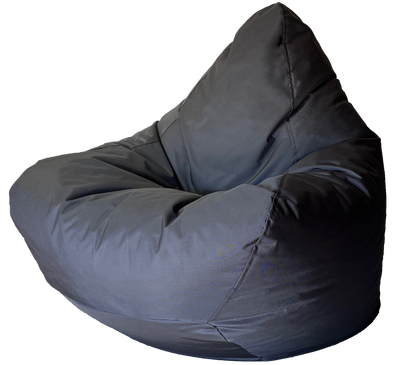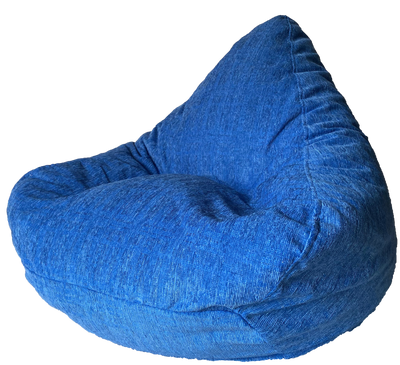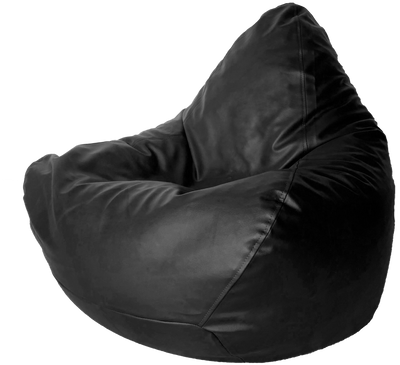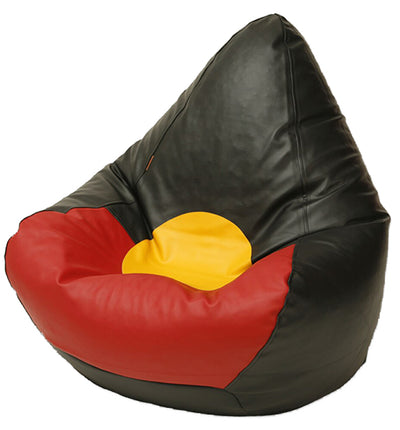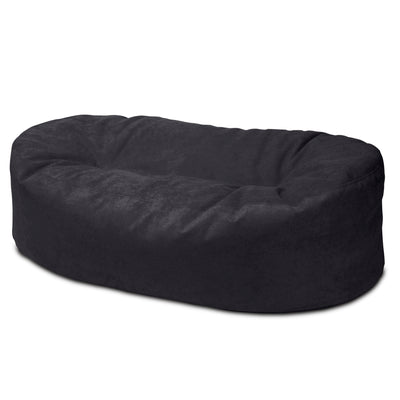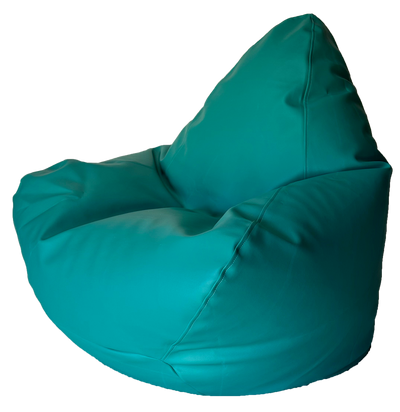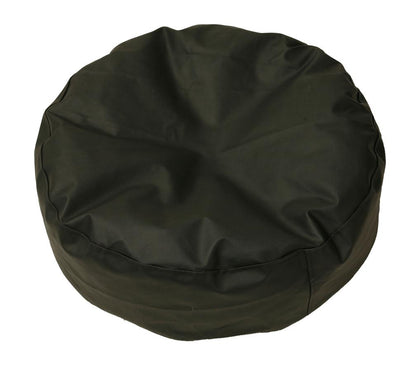King Kahuna bean bags are manufactured to the highest quality and safety standards. To ensure your bean bag leads a long and happy life, follow the directions below.
General Hints & Information
Please avoid unnecessary rough treatment including jumping into your bean bag.
Maintain the level of filling with King Kahuna DOUBLE STRENGTH - DOUBLE DENSITY™ bean bag beans.
Book a time to get your bean bags filled at our Melbourne store.
If you're interstate or in a regional area, you can fill with regular beans available from most supermarkets and department stores.
A bean bag is not a flotation device, so please don't try swimming with it.
Tabs have been removed to prevent children opening the bag.
To Open: insert paper clip, safety pin, etc. into hole on side of zipper head, there is a small bar in there, (the locking mechanism) the pin must be under it, then gently lift and slide open.
If the zip doesn’t move freely DO NOT FORCE, reinsert pin and try again.
NEVER USE PLIERS: Forcing of the zip by hand or using any other implement other than prescribed method will void the guarantee.
All zips are checked at time of manufacture.
All King Kahuna beanbags are hand made to ACCC standards and double stitched with nylon bonded threads. Only the highest quality materials are used.
Our One Year Guarantee covers the unlikely advent of faulty material or workmanship but excludes misuse, neglect and standard wear and tear. Proof of purchase is required.
Find out more about our guarantee details, safety information and our full Three Year Guarantee.
Care For Fabrics
Please note: It is impossible to provide cleaning instructions for all fabrics as the wide range of fabrics available my require slightly different cleaning solutions or procedures, however, following the guidelines below should ensure your bag gets the attention it requires.
Follow these tips for great fabric care:
- Overall professional cleaning is recommended annually.
- Protect from direct sunlight.
- Rotate regularly.
- Using low suction, vacuum fabric regularly (weekly is recommended).
- To avoid scorching and moisture build up, avoid contact with external wall and radiators/ heaters.
- Avoid bringing sharp objects into contact with the fabric as this can result in snagging or tearing of the fabric.
Important to remember no fabric is 100% colourfast. If precautions are not taken fading may occur. Low winter sun can do the most damage to fabrics, as well as fabrics located in a northerly faced location or fabrics constantly exposed to the sun.
Constant and direct sun exposure will result in the break down of the fabric fibres, which results in the fabric becoming brittle and the affected area may break when cleaned. Dyed fabrics will be susceptible to light fading.
All fabrics are prone to shrinkage, allowances for this have been considered in the design process of your King Kahuna product.
Piling can occur as a result of normal daily wear. Should not be considered as a fabric fault. Occurs when the fabric surface is rubbed, a single or group of loose fibres on this surface twists upon itself, forming tiny balls known as pills.
Foreign fibres or specks of dirt are normally the cause. Specific clothing types (fleece tracksuits etc) can transfer pills to fabric. Climatic conditions and environment can also result in pilling.
Pills can be removed with a battery operated pilling machine. De-pilling does not affect fabric in anyway other than removing the loose surface fibres.
Prevent yellowing and oxidation by keeping your bean bags away from smokey environments.
Light or white fabrics are more susceptible to yellowing. Yellow/brown stains may occur on fabrics as a result of fumes and atmosphere from a room where tobacco is smoked.
When sulphur compounds (resulting from combustion, open and gas flames, auto exhausts, chimneys, stoves) mix with humidity and oxygen, a mild sulphuric acid is produced. Deterioration and discoloration occur when this sulphuric acid is absorbed by or settles onto the fabric.
We recommend that spot cleaning products be purchased from furniture retail stores or professional upholstery cleaning technician.
Cleaning Instructions
Follow the cleaning instructions below depending upon your bean bag's material.
Marine Grade Vinyl
- Commercial grade.
- Scratch resistant.
- Flame retardant.
- Refined surface texture.
- Complies with highest standards in fabric quality.
- Extremely hard wearing and durable.
- Developed to withstand rigors of marine and harsh outdoor conditions.
- Antimicrobial; sanitized to inhibit growth of bacteria, mould and mildew.
- U.V. protection to resist fading and discolouration in outdoor conditions.
Clean with eucalyptus oil (preferred). 40:60 ratio of eucalyptus and water for general cleaning. Undiluted for tough marks.
OR use warm soapy water to clean. Wipe over with a damp cloth to remove excess soap and water. Regularly wipe down headrest, arm and seat areas to remove perspiration and oils. Treat stains and spills as soon as possible.
IMPORTANT: Regularly clean to remove perspiration and oil.
- Do not use harsh detergents.
- Do not use a wire brush.
- Do not dry fabric next to heater/radiator.
Macrosuede / Corduroy / Shag (Faux Fur)
- Easy to clean.
- Hard wearing.
- High quality, developed to last and woven to precise specifications.
- Colourfast, abrasion and inherent stain resistance tested and passed to exacting standards.
- Easy removal of most common household stains such as tea/ coffee, red wine, chocolate, shoe polish, make up and most ink if tended to promptly, following manufacturer's cleaning guidelines.
Bean bag liners are available for all sizes of our Macro-suede, Corduroy and Shag beanbags to make cleaning quick and painless.
Remove excessive dirt with soft brush. Spray with warm water (not exceeding 40°C) and air dry. Fabric should be thoroughly cleaned periodically by:
- Removing excessive dirt with soft brush.
- Spraying with warm water (not exceeding 40°C).
- Applying gentle soap solution.
- Stand for 20 minutes.
- Thoroughly rinse.
- Air dry only.
- Do not use harsh detergents.
- Do not use a wire brush.
- Do not dry fabric next to heater/radiator.
Outdoor Fabrics (Recacril)
- 100% solution dyed acrylic.
- Superior woven construction- Breathable fabric, allowing air circulation.
- Lightweight.
- Durable.
- Designed to withstand outdoor and marine conditions.
- High fading resistance.
- Protected against rot, mildew and discolouration in normal conditions.
Using low suction, vacuum fabric regularly - weekly is recommended. To avoid scorching and moisture build up, avoid contact with external wall and radiators/heaters.
Avoid bringing sharp objects into contact with the fabric as this can result in snagging or tearing of the fabric.
Remove excessive dirt with soft brush. Spray with warm water (not exceeding 40°C) and air dry. Fabric should be thoroughly cleaned periodically by:
- Removing excessive dirt with soft brush.
- Spraying with warm water (not exceeding 40°C).
- Applying gentle soap solution.
- Stand for 20 minutes.
- Thoroughly rinse.
- Air dry only.
- Do not use harsh detergents.
- Do not use a wire brush.
- Do not dry fabric next to heater/radiator.
Spot Cleaning Guide
We recommend that spot cleaning products be purchased from furniture retail stores or professional upholstery cleaning technician.
Blot up moisture with absorbent towel. Dampen a clean cloth in rubbing alcohol and dab affected area.
Then, with a cool water and liquid detergent mixture, blot repeatedly. Blot dry with a clean towel.
With cool clean water, again dab affected area. Blot dry final time.
Apply sparingly to affected area a mixture of ammonia (1 teaspoon) and cold water (1 cup). Blot with a clean towel. Repeat until blood has disappeared.
Wait 15 minutes.
Then, with distilled white vinegar, moisten the area. Blot thoroughly with clean, dry towel.
Harden the gum by rubbing with an ice cube.
With a dull knife, scrape off excess.
Use dry cleaning fluid to remove the remainder of the gum.
Scrape away excess.
Apply a liquid detergent and cool water mixture. Thoroughly blot.
Clean with dry cleaning fluid.
With warm water, sponge affected area.
Apply warm glycerine, leave for 30 minutes.
Flush with water and quickly dry.
Blot up or scrape away excess. With cool water, blot affected area.
If stain remains: Add one drop of vinegar and small amount of liquid detergent to the water.
Blot with the above mixture until the stain disappears.
Apply clean water to remove any traces of the vinegar.
Scrape away excess.
With a dry cleaning fluid, dab the affected area repeatedly.
If stain remains: Apply mixture of liquid detergent and lukewarm water.
Moisten a clean cloth with cool, clean water and blot.
Scrape away excess.
Apply mixture of liquid detergent and cool water.
To avoid saturating the fabric frequently blot area.
Leave to dry.
Dab remaining stains with dry cleaning solution. Blot dry.
Moisten affected area with glycerine, leave for 10 minutes.
Apply a liquid detergent. Brush lightly.
Flush out with clean water and dry quickly.
Rub with a cut lemon.
Sponge with warm water. With a clean cloth, apply small amount of detergent. Blot stain.
Wring out cloth dipped in white vinegar and warm water solution (2/3: 1/3), dab affected area to remove soapy residue.
Blot or scrap away excess.
Apply clean cool water, frequently blotting.
Add small amount of ammonia to a liquid detergent. Apply to affected area, blotting.
Blot dry, wait a few minutes.
Apply dry cleaning fluid, blot dry.
Moisten a clean cloth with rubbing alcohol and lightly dab the area.
Loosen the stain by applying liquid paraffin.
Sponge with a dry cleaning fluid.
Sponge with water.
Work warm glycerine into the stain.
Flush out with clean water. Dry.
Sponge with warm water.
Apply warm glycerine.
Leave for 30 minutes.
Flush out with warm water. Quickly dry.
Important to treat this stain right away before drying occurs.
Urine can react to the fabric dye, resulting in permanent discolouration.
Dab the affected area with a mixture of water and white vinegar. Blot dry.
Then apply mixture of cool water and liquid detergent.
To avoid saturating the fabric, blot frequently with a dry cloth.
Dab with cool clean water. Blot thoroughly.
Thoroughly blot. With white vinegar, dampen the entire affected area.
Wait until dry.
Moisten again with clean water.
After every application of water, blot dry with a clean, dry towel.
Pile fabric should be brushed in the pile direction once dried.




